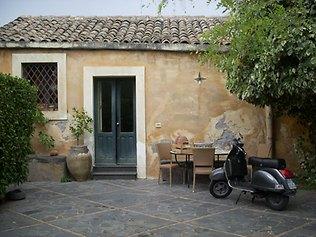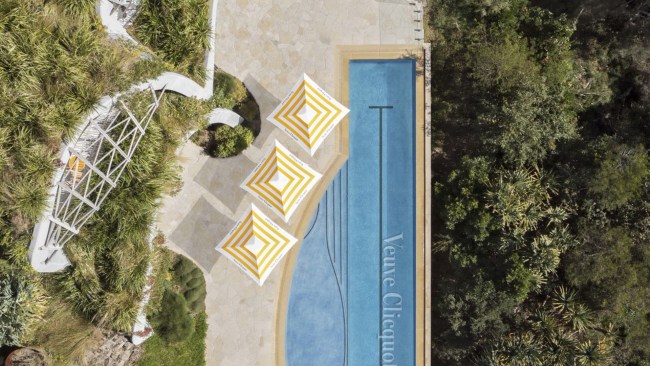Rustic Italian food from the heart
A COOKING school in Sicily focuses on local dishes and produce.

ANNAMARIA Simili, the cook at Azienda Trinita, is using a cheese grater to peel off long, thin slices of zucchini to mix with golden olive oil, lemon juice, walnuts, mint and parmesan cheese to create a carpaccio de zucchini salad. Fourteen eager observers are crowding around the island bench in the airy kitchen of this Sicilian family estate, hoping to soak up the culinary ambience like the zucchini is absorbing the flavour of the oil.
Later, we will eat the fruits of Simili's labours in the large open dining room of the farmhouse, which dates from 1609. But first there's the caponata to master, followed by the pasta Eolian, chicken with grapes and crostata pastry tart with peach jam.
I have joined this Sicilian Cooking and Gardening tour of the Azienda Trinita estate at Mascalucia in the island's Catania province as part of a cruise ship shore excursion.
But the villa also offers a cooking school and day tours as well as accommodation and meals for independent travellers.
The estate, named after the 16th-century Santissima Trinita (Holy Trinity) church next door, is tucked away behind tall gates in the back streets of the town of Mascalucia, with Mt Etna looming in the background. The rich volcanic soil, interspersed with veins of solid lava, is the basis of owner Salvatore Bonajuto's extensive garden, filled with exotic and native plants and, in particular, a citrus grove where he is attempting to revive heritage strains by grafting on to ancient root stock.
The history of citrus cultivation in Sicily in many ways follows the island's - and this family's - cultural roots. It is thought the Arabs introduced citrus trees to Sicily, with more varieties brought later by the Spanish. Salvatore and Marina Bonajuto and their son, Antonio, are the eighth generation to have owned Azienda Trinita since the family came to Sicily from Spain in 1300.
On a tour of the 3ha garden, Salvatore proudly shows the gravity-fed irrigation channels, called saje, that were used to direct water around the estate, systems first built by the Arabs.
The garden, listed by Grandi Giardini Italiani, is a source of produce for the cooking school, all contributing to the distinctly Sicilian flavours.
Back in the kitchen, Simili explains that every town has its own version of caponata, a dish that again reflects a Spanish influence. Some recipes add tomato, potato or olives, even pine nuts and raisins, to achieve caponata's earthy blend of oily, sweet and sour flavours. Her recipe uses sunflower oil to fry chunks of eggplant that have been soaked in salted water for at least an hour. The eggplant is mixed with fried red and green peppers, celery, onions, capers and her special ingredients: the agrodolce or sweet and sour combination of local zagara (citrus flower) honey and white apple cider vinegar.
With a final dressing of virgin olive oil, the dish is served at room temperature along with chunks of freshly baked bread cut from loaves shaped into large rings.
The kitchen is heating up now as the caponata is set aside and the zucchini salad is resting on a corner of the bench. Simili, whose Roman mother taught her to cook pasta and who once stepped out with a member of the Barilla family, has turned her attention to the pasta Eolian.
She uses a small kitchen knife to dice a mountain of plump cherry tomatoes, adding whole cloves of garlic and a generous measure of local capers to olive oil in a pan. When the capers open, in go the tomatoes to cook down to a rich sauce, to be served with fresh pasta, torn basil and salt.
The chicken dish is a sublime balance of flavours from a few ingredients: chicken breast pieces dusted in flour and fried with golden onions, salt and pepper, then simmered in white wine and finished with red grapes.
Our final dish, the crostata, is a circle of crumbly butter pastry spread with jam and topped with a lattice of thin pastry strips -- hence the name. The filling is peach jam, made with local fruit, but could instead be citrus marmalade or a seasonal variation.
Together, these dishes - all based on fresh, local produce - make a superb lunch eaten on check-cloth covered tables set with tumblers of the family's wine, with son Antonio's image on the label and made from grapes grown nearby.
The rustic villa, the slightly ramshackle garden with its persimmons and pomegranates, herbs and vegetables, citrus and olive trees, as well as the family history of the place, the relaxed pace and laid-back attitude are like the food - simple ingredients that seem to go together well.
On this perfect day, I have tasted a little of Sicilian culture and history along with its cuisine.
Checklist
Azienda Trinita, 34 via Trinita, Mascalucia, Sicily. The estate includes eight rustic guestrooms; bed and breakfast for two is E45 ($60) a person. A simple dinner is E20. A cooking lesson for two residents including dinner is E60 a person. There is also a five-day cooking class, including lunches, dinners and excursions. More: aziendatrinita.it.



